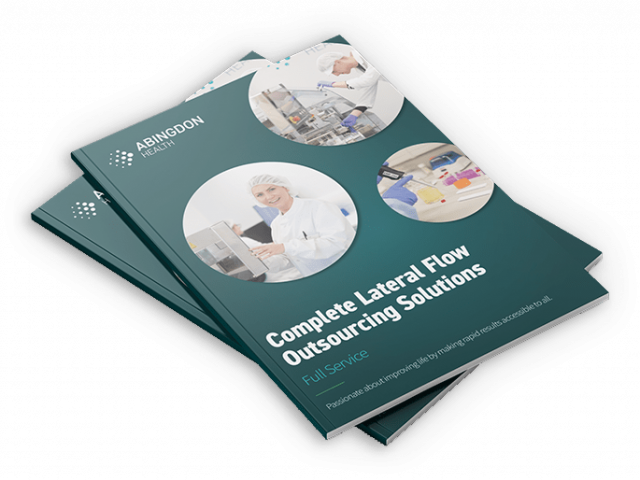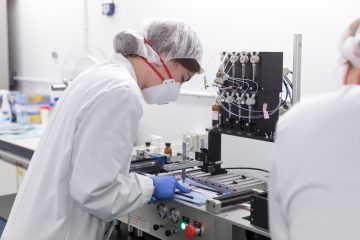Close-to-Market LFT Supply Chain Solutions: Greater Efficiencies and Stable Budgeting

The Current Issue
The Long-Term Valued Added Benefits
Shorter Lead Times
Key Take-Away
Supply chains are truly global and, in some cases, unpredictable owing the recent economic and geopolitical events. In our world of lateral flow test manufacturing (LFT manufacturing), test owners are now more likely to look for alternative business models. Close-to-market supply chain solutions may become commonplace as businesses look to sure up supply and de-risk operations.
Therefore, in this article, and drawing on the experiences of our customers, we discuss the benefits of close-to-market supply chains in negating the challenges of working with manufacturers far away from an organisation’s key markets.
The Current Issue
Many would assume working with Far East lateral flow manufacturers would suit an optimum model for supply. Communication and time zone challenges associated with working with the Far East has always been there. But in fluctuating economic times, these common challenges become amplified when time and efficiency is critical for continuity of supply and brand perception. Changes must happen, and businesses need to maintain a laser-like-focus on margins and meeting demand to assure business-viability.
Supply chain issues for finished goods from the Far East has been well documented. Global financial crises, lower demand for non-essential goods and the lingering impact of the COVID-19 pandemic being some of the reasons why. In fact, container ships have cancelled voyages1 and FedEx cut capacity and grounded aircraft2. This has a knock effect for essential goods, such as medical devices or animal health tests, for example. Delayed or cancelled shipping slots result in missed or delayed revenue and/or potential additional warehousing or courier storage costs. And when goods are travelling 5,000 miles, it is very difficult to offer alternative freight options to offset delays. Batches normally sent by sea; would there be enough room on air freight? Vice versa the time impact won’t be favourable. And road freight is not an option! The negative impact on end-user and stakeholders is quite significant.
Reducing the gaps between the manufacturer and the markets can open-up road freight solutions. Especially for Abingdon Health. We are connected to every corner of Europe via the channel tunnel and multiple shipping lanes in addition to air freight.
Some would say every part of the supply chain is global and challenging, and just doesn’t impact finished goods supply. That is correct, but this is where using tried and tested procurement and inventory management procedures come into their own. When managed properly and with the right warehousing and storage solutions, it is more straightforward to hold inventory for lateral flow test raw materials. Finished products are manufactured to meet demand and forecasts. But raw materials are ordered by lateral flow manufacturers to service many contract customers. So with the right planning, the perceived challenges can be reduced and this why project management is essential in hitting LFT manufacturing objectives.
The Long-Term Valued Added Benefits
 It is well known UK, European, and North American markets have relied on Far Eastern LFT manufacturing. But this trend will change with reshoring, onshoring and near-shoring being more common as businesses look to maintain efficiencies and stabilise budgets. For example, US and global test owners will favour manufacturers closer to their UK and European markets and UK and European test owners will bring manufacturing closer to home.
It is well known UK, European, and North American markets have relied on Far Eastern LFT manufacturing. But this trend will change with reshoring, onshoring and near-shoring being more common as businesses look to maintain efficiencies and stabilise budgets. For example, US and global test owners will favour manufacturers closer to their UK and European markets and UK and European test owners will bring manufacturing closer to home.
The closer proximity offers greater control over supply and the ability to meet demand as markets ebb and flow. Resulting in reliability of supply with customers repeat-ordering with a trusted brand and supplier.
Shorter Lead Times
The proximity of a LFT manufacturer to the market can have a cost and efficiency impact. Optimum speed and reliability of supply is critical for maintaining great customer relationships. For Abingdon Health with established links into the UK and European markets, the shorter transit times reduces lead times.
Also, by combining optimum LFT pack sizes, to fit as many kits on a pallet, and shorter transit times, this can have environmental, margin and shipping pricing benefits per shipment. Less pallets in-transit means less CO2 per shipment and lower shipping costs can positively influence margins and the end-user costs. Which is appealing for many stakeholders.
Key Take-Away
Reliable lateral flow manufacturing and favourable lead times contribute to a continuity of supply that appeases customer needs and forms the base for success in the short and long-term. Brands need to have confidence they can supply customers on time and in full (OTIF) and in turn customers can’t wait for their products.
No supply chain is going to be perfect, and the aim is to reduce bumps in the supply chain. But idly waiting for months or years for economic and geopolitical events to die down is not going to help stakeholders get tests they need.
The volatility of economies and supply chains will result in businesses going back to basics and choosing more favourable supply chains options. Close-to-market supply chain solutions is a big part of this. Shipping finished goods from the other side of the world is accepted of course, but distances, environmental impacts, communication delays, and unreliability of scheduling is something that business owners will start to get very tired of. Also, if fuel prices remain high shipping costs from the Far East will become too much for some test owners to swallow!
 Abingdon Health has established trusted and long-lasting relationships with multiple suppliers and logistics partners, alongside having invested in state-of-the-art facilities and some of the best lateral flow manufacturing minds in the industry. Project planning, contingency planning and risk management is all part of what we offer to our customers. All these actions are dynamic, and Abingdon Health’s role is to ensure that we manage our customers’ products through this manufacturing journey, and pro-actively ensure the best possible outcomes.
Abingdon Health has established trusted and long-lasting relationships with multiple suppliers and logistics partners, alongside having invested in state-of-the-art facilities and some of the best lateral flow manufacturing minds in the industry. Project planning, contingency planning and risk management is all part of what we offer to our customers. All these actions are dynamic, and Abingdon Health’s role is to ensure that we manage our customers’ products through this manufacturing journey, and pro-actively ensure the best possible outcomes.




